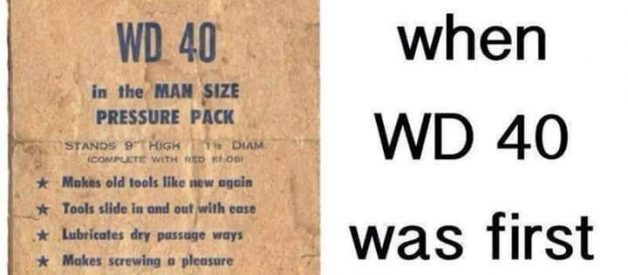 Source
Source
It was once used to protect the outer skin of the Atlas missile from rust and corrosion. It has over 2,000 recorded uses, some of which include the removal of lipstick from shirt collars, the cleaning of an AK-47 magazine, and the maintenance of radar equipment. Fun fact ? the original formula was sold by the inventor to his team for a mere $500.
This material was WD-40 and was first invented in the 1960s by Norman Lawson while trying to create a solution that prevented metal parts from rusting. It was named WD-40 because it stood for ?Water Displacement: 40th Formula?, meaning that it was the 40th and the only successful attempt. The creator?s name is quite often confused with Norman Larsen, the president of Rocket Chemical Company (now the WD-40 Company).
The exact formula of WD-40 is a closely-guarded secret. But a bit of research revealed that it contains three main ingredients; a thick oil, a volatile hydrocarbon, and a propellant. The propellant allows the solution to spread over a large area, over which the hydrocarbon-oil solution settles. The hydrocarbon evaporates, leaving behind the oil, which acts as a shield between exposed metal and moisture.
So, is it a spray that does it all? Pretty much. Here are some ways you can use WD-40 for automotive maintenance:
1. Loosen rusty nuts and screws
How ? Apply liberally, tap with a spanner or a hammer
 Source
Source
2. Tighten nuts and screws
How ? If the threads are rusted, tightening nuts and screws becomes difficult. To prevent this, use WD-40 before tightening any metal fastener. Wipe clean with a cloth after tightening.
3. Lube rusty keyholes
How ? Use the straw that comes along with every WD-40 can. Insert the key to about half an inch, and then spray liberally. Remove the key, insert it, and turn it a few times. Keep spraying until the action feels smooth.
4. Free up switches and indicator stalks
How ? Try to insert the straw in the gaps between the switches or indicator stalks and the dashboard. Then, tap the surfaces as much as you can (Switch between ON and OFF positions). Wipe off the extra WD-40 once the action smoothens.
5. Remove stickers from windows
How ? WD-40 can literally melt away all kinds of adhesives ? Period. To remove stickers from any kind of glass surface, spray WD-40 liberally and let it sit for a while. Then scrape off with a widget or scrubber.
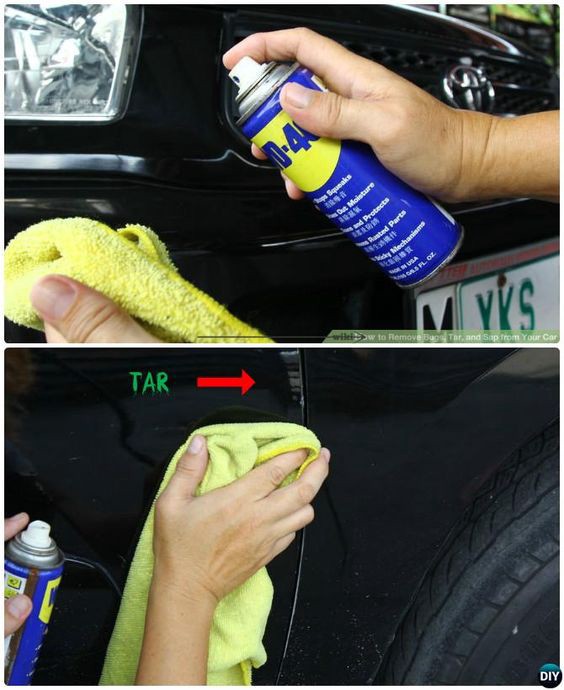 Source
Source
6. Clean water spots from mirrors
How ? Often, at car washes, the soap they use leaves behind residue which is difficult to remove. To clean these spots, apply WD-40 over the area and wipe off the excess with a cloth
7. Remove scuff marks
How ? Whether on the floor mats or the running boards, spray in a linear fashion, and let the WD 40 sit. Wipe off with a clean cloth.
8. Clean cup holders
How ? Use the straw to spray, starting from the base, then coming up to the top. Wipe with a clean cloth once you see the stains loosening.
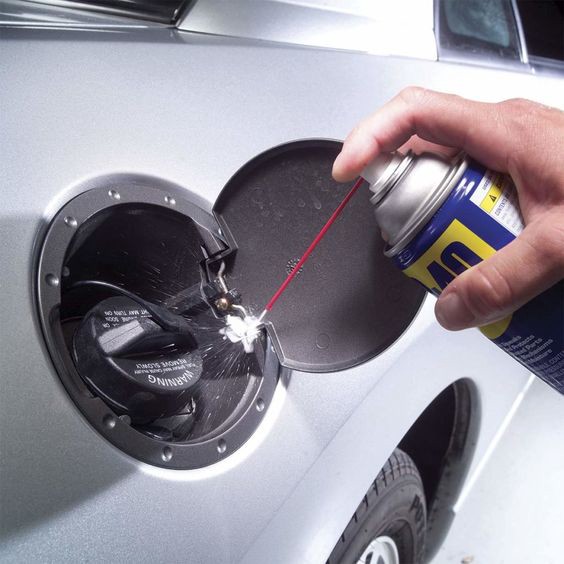 Source
Source
9. Clean gum from seat covers/floor mats
How ? Fun fact: WD-40 was once used to remove a boa constrictor that had lodged itself in the engine bay of a car. Considering that, how hard can it be to remove chewing gum from a car seat or the floor mats? Squirt some ?40 around the affected area, remove the gum with a bit of tissue paper, and wipe clean with a cloth.
10. Clean windshield
How ? Apply in a circle, starting from the top of the windshield, without the straw. Wipe with a clean cloth in the same direction.
11. Clean grille
How ? Apply in straight lines. Start from the outer edges first, and then move into the inner section. Let it sit for a while, then wipe off with a microfiber cloth.
12. Debug all glass surfaces
How ? Since WD-40 is a lubricant, any bug that hits or decides to sit on your car windshield, mirrors, or grille will slide off. To debug all glass surfaces, apply WD-40 liberally on all exposed surfaces and let it sit. Clean with soap and water afterward.
 Source
Source
13. Clean plates
How ? Apply liberally on rusted registration plates, and then allow the solution to sit. When you see the rust melting away, wipe off with a clean cloth. Repeat this procedure on both sides.
14. Polish chrome
How ? Apply all over chromed surfaces, moving in one direction. Wait for a few seconds, and then clean with a cloth, moving in the reverse direction.
15. Restore headlights
How ? Apply on the outer surface of the headlight cluster, starting from the top. As small bubbles begin to appear, wipe down with a soft, clean rag. Works well if your car has pop-up headlights, too.
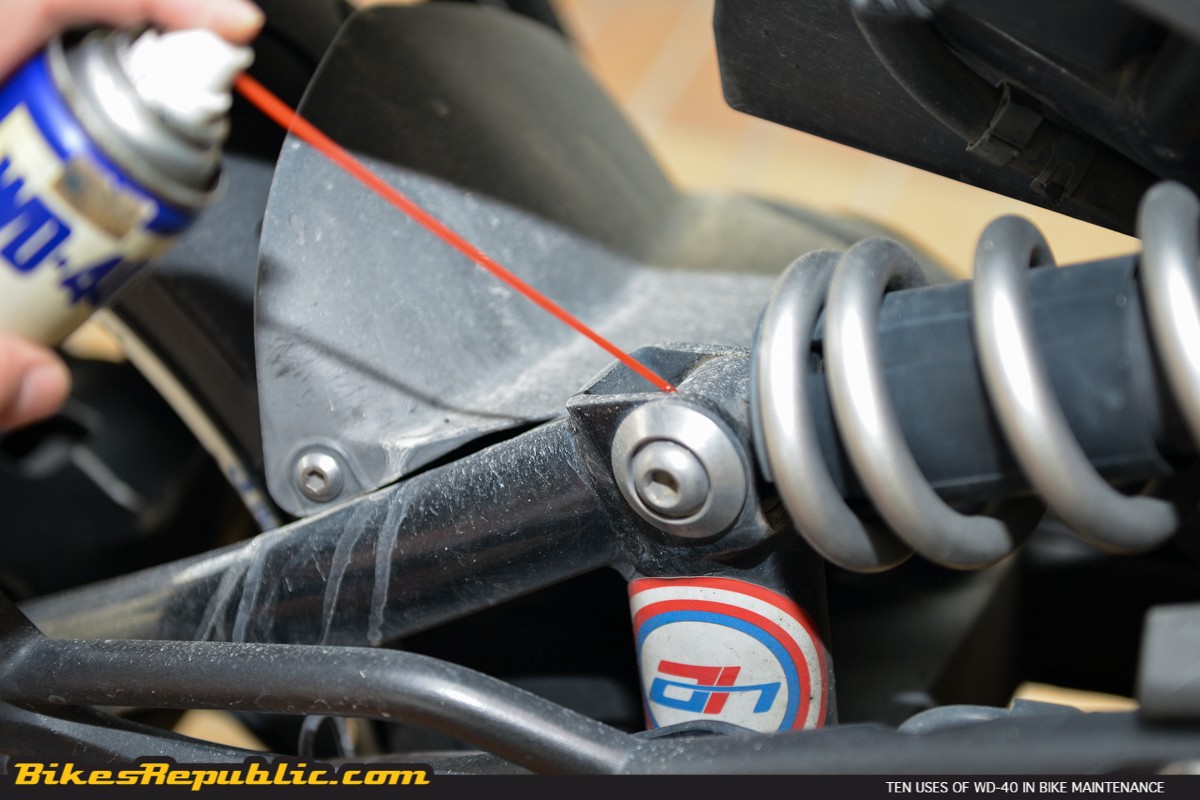 Source
Source
16. Fix minor scratches
How ? This requires a lot of muscle. Here, too, you need to spray WD-40 liberally on the surface to be fixed. Then, with a coarse cloth, rub off the scratches. Keep at it until the surface looks as good as new.
17. Clean engine cover
How ? Raise the hood, dust off the cover with a dry cloth first. Then, spray WD-40 all over the cover. Wipe off with a clean cloth.
 Source
Source
18. De-water flooded parts
How ? Sometimes, water enters critical engine parts like the air filter or the ECU bay if a vehicle has been driven in the rain. To prevent this, raise the hood and spray WD-40 on all exposed parts. Lower the hood after it evaporates.
19. Free up frozen doors
How ? Open all four doors, spray some WD-40 into a rag, and wipe the door seals. Then close all doors, open them, and do it again, till the door seals start to shine a little. Do not spray directly, as some of it will seep into the passenger cabin, and your car will smell like a can of WD-40.
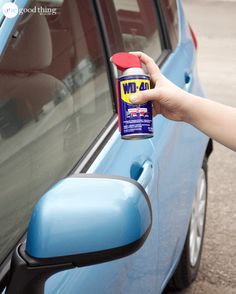 Source
Source
20. Fix squeaking suspension mounts
How ? This, again, will require a little more than just a can of WD-40 and a rag. You?ll need a flexible rubber tube (or a wand) that attaches to the WD-40 can and a jack to raise your car. Once raised, spray the bushings, starting from the ones on top of the suspension arms. Then move down towards the bottom, finally spraying it on the steering bushes as well. Be careful not to let any of it leak onto the brake discs.
 Source
Source
21. Clean battery terminals
How ? Dust, moisture, and heat can damage battery terminals, resulting in battery drain and electrical shorts. To prevent this, spray WD-40 on the battery terminals. As the metal surface seems to take on a new shine, wipe off with a clean cloth. Don?t do this while the battery is hot.
22. Free up spark plugs
How ? Carbon deposits and grime harden up over time. This buildup makes it very difficult to remove spark plugs during an overhaul. To free up jammed plugs, spray WD-40 first around the plug caps, loosen them, and then on the plug heads. Wipe off the excess once you?ve extracted the stuck plugs.
23. Protect wiring
How ? Rain and snow can wreak havoc with electrical wiring. If you?re planning to change a wiring harness in your car, protect it by spraying the insulated areas with WD-40. Be extra careful while wiping off any overflow.
24. Protect wipers
How ? Since WD-40 consists of viscous oil, it protects exposed surfaces from friction during contact. Windshield wipers consist of thin strips of rubber that may crack if dried up. To prevent this, spray them with WD-40 and let it sit for a while. Wipe off the excess.
 Source
Source
25. Clean and shine rims
How ? First spray clean water to loosen any road tar or dirt on the rim. Then, wipe all the water clean with a cloth. Once it dries, repeat with WD-40 and a clean cloth. Do not let any of it flow down to the tire surfaces, or it will cause a severe lack of grip while driving. It?s a lubricant. Remember that.
 Source
Source
According to some delighted WD-40 fans, a few other ways to use it include the riddance of Silly String stains, the removal of crud from the stoppers of antique perfume bottles, and the freeing of a parakeet trapped in mousetrap paper. It?s as if the little blue-and-yellow spray can is God?s answer to all our problems. And in most cases, it really is.
Conclusion: You need only two tools in life ? WD-40 and duct tape. If it doesn?t move and it should use the WD-40; if it moves and shouldn?t, use the duct tape.
Sources –
https://www.wd40.com/myths-legends-fun-facts/
https://www.datocms-assets.com/10845/1562642906-wd402000usesupdatedjan2017.pdf
